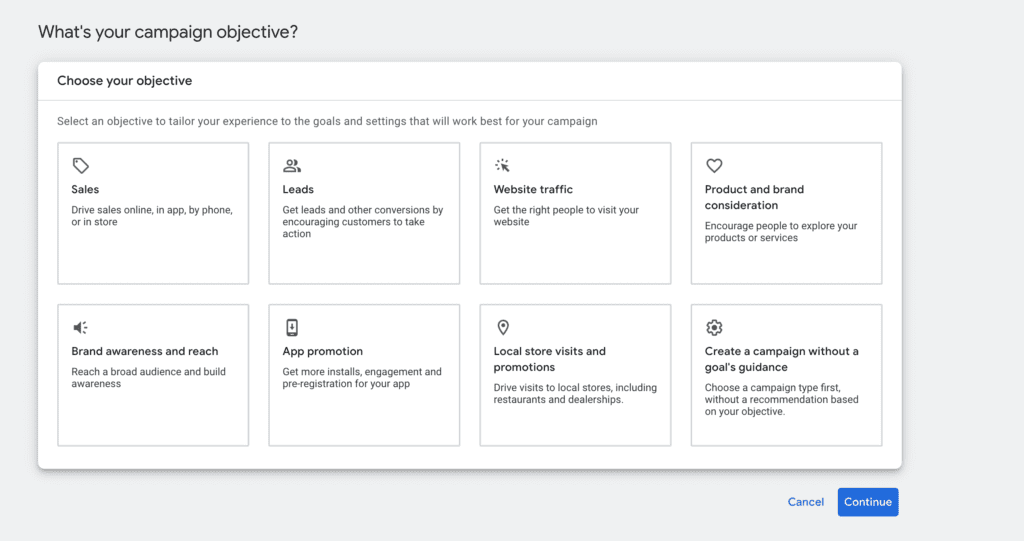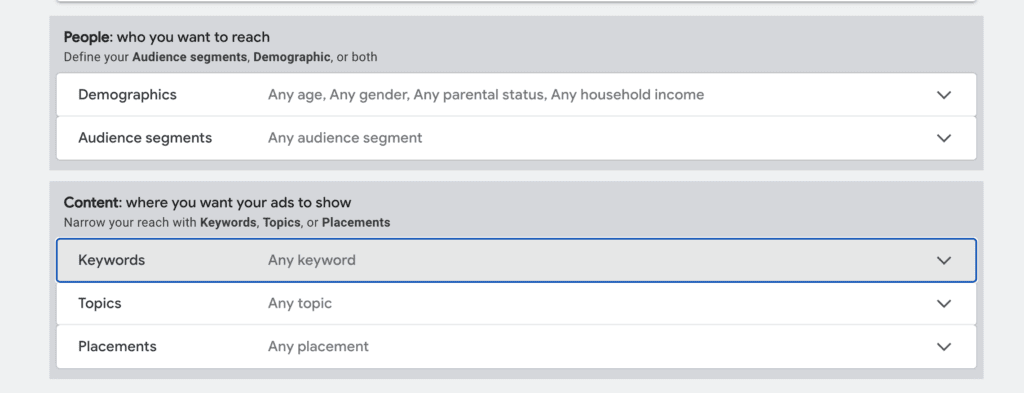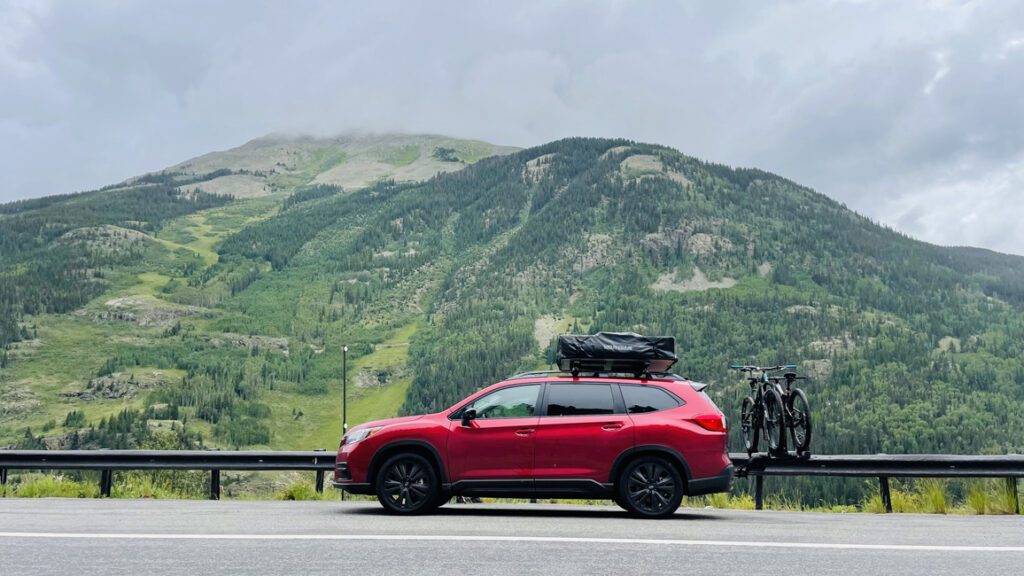Creating your first Google Ad
You may think Google Ads are extremely complicated to set up and actually see conversions from your effort. And this is often why many small businesses and non-profits do not use them as part of their marketing strategy. However, this DIY tutorial will give you everything you need to set up your first Google Ad!
First, if you haven’t read the earlier blog in the Google Ad Series, Getting Started with Google Ads, read it now! Next, we know you came here for an action plan, so let’s get you set up with your first DIY Google Ad!
1. Select Your first Google Ad Goal
Once you’ve set up your Google Ads Account, you can click on the blue plus sign to create a new campaign. Next, you will be asked to select your campaign objective.
Now then, decide whether you want to drive traffic to your website, generate more leads, or simply create brand awareness.

When you create your first Google Ad, you’ll need to first decide what your campaign objective is.
2. Select Google Ad Campaign Type
Next, select your campaign type. This means choosing your ad type- so a display ad, a video ad, or a Performance Max ad…If you’re not sure of the difference between each, go back and review the first blog in our Google Ads series.
You’ll have some sub-campaign choices to make and then you can move to the next steps!
3. Set up Your Google Ad Budget and Choose the Location You Want Your Ads to Be Shown
The next steps are to name your campaign, set your Google Ad budget, and the dates you’d like your ad to run. You can have your ad run continuously until you decide to turn it off.
We recommend starting with a small Google advertising budget. $5-15/day until you get the hang of it. $5/day is perfect if you’re a small business and have just a little wiggle room this season!
In this step, Google may show you a few examples of a daily budget amount, with your estimated reach and link clicks per month. You can also create a custom amount. Either way, pay attention to these numbers- the estimated number of people reached and the estimated number of clicks. Write them down. Revisit them to see if your Google ads are performing as expected.
Some things to think about:
- Is this a limited campaign- just a few weeks long? Or, will this be ongoing?
- Do you have the time now to manage a campaign and check up on it every day? If not, can you put someone in charge of running it for you that already has ad experience?
- Did you know you can change your budget or pause your ad at any time?
Then it’s time to select what locations you want your ads to be shown. Are you targeting a local market? Or more wide-ranging? Keep in mind, to make your Google Search ads most effective, you’ll want to dial in that location!

If you are not able to manage your Google Ads campaign, hire an expert, or put someone in charge of running it for you that already has ad experience.
4. Dial in the Demographics: Identify the People You Want To See Your Google Ad
At this point, you can create more parameters around the demographics or the types of people you would like to be shown your first Google Ad. This means choosing age, gender, parental status, household income, etc.
Following this, you can select keywords, content topics, and other placements to further narrow down your audience.
Identifying Google Ad Keywords
Be specific with your Google keywords and keyphrases here. As an example, if you’re selling camping gear, what specific types of camping gear? Is it for sleeping, cooking, or hiking?
In addition, selecting a single keyword like ‘camping’ could get you lots of clicks. However, it may not get you conversions if you’re directing the wrong customers to your website. In addition, you’ll be paying for all of those clicks!
Therefore, we recommend using long-tail keywords. What is a long-tail keyword? Here are some examples: “best mountain bike for kids”, “cold weather sleeping bag” or “easy to use camp stove”.
How do you create a list of good long-tail keywords for your ad? In this step of your first Google ad campaign creation, you can enter the name of your product or service, or your website URL and Google will help you by providing lots of relevant keywords. Select which Google keywords you want to keep, and remove the ones you don’t. Add a few keyphrases of your own and then move on to the next step!
Need more tools to help you find good Google keywords and Keyphrases:
Remember, be as specific as you can. Therefore, if you’re selling bicycles or cycling gear, be strategic with the types of bicycles or gear you are selling. Examples: “men’s road bikes for sale”, “clothes to wear cycling”, or “padded bike shorts”. Keep in mind, not everyone knows cycling gear as cycling kits, bibs, or jerseys!

Dial in those demographics for who you ideally want to see your first Google ad.
4. Upload Images or Videos and Write Your First Google Ad Copy
Now onto the fun stuff…selecting photos, videos, and word-smithing your Google headline and descriptions! Have some images and a video or two in mind. And have copy ready that you are using on your website, in email campaigns, or for social media posts. You’ll be very limited with the number of characters you can use in the copy: 30 characters for headlines, 90 characters for descriptions.
Once again, be strategic and give people as much information as you can, but remove excess wording, punctuation (Google does not like exclamation points), and anything that’s unimportant. Often, we’ll look at what posts are performing best on social. We may also keep an asset list of the copy we are using, and what’s performing well.
After your first Google ad is up and running, a selection of best-performing headlines and descriptions will be created for you automatically. You can view it under the Asset Details of each ad.
At this point, if you have questions and want to book a consult with us to walk you through setting up your first Google Ad, drop us a line, and let’s chat!
Want to learn more about our services to identify everything from the right audience to the best copy and imagery? Read on to see which clients we’ve supported with Google advertising!

Add images or a video to your campaign that helps capture your audience’s attention- so that they can see themselves using your product on their next road trip or summer vacation!
6. Track Your Progress
After you publish your first Google ad, stay engaged with the platform. Ensure your ad is approved and begins the learning phase. This could take 48-72 hours or longer. However, please know your budget will not be spent during this time.
Once the ad says ‘Approved or Eligible’ you are on your way! If you’ve run ads on platforms like Facebook and Instagram, your ads may have been approved and running much more quickly. With Google, ads can take longer to get approved and go through the learning phase. Therefore, stay patient and check in every day.
What should you do if your first Google ad is rejected? If your ad is rejected, you will receive a notification in your account. Make the necessary changes and submit it again for approval.
Continue to review your Google Ad analytics over time. Check up on how your keywords are performing. Pause ads that are underperforming and increase your budget on those that are performing well. Need help, call in an expert!
Here are a few more blogs that might help you create more brand awareness and traffic to your website:
- Using Photography and Videography to Marketing Your Business
-
How to Find the Right Brand Ambassadors and Influencers for Your Brand
- Best Email Marketing: How to Improve Open Rates and Clicks
Meredith McConvill, Top Rope Media
Hello colleagues, its enormous article concerning educationand entirely explained, keep it up all the time. Othelia Berke Orsa
Thank you!
If you want to use the photo it would also be good to check with the artist beforehand in case it is subject to copyright. Best wishes. Aaren Reggis Sela
Thank you, we take most of our own photos and screenshots of our work for just this reason. And, if we do not, we use images from Adobe Stock, Canva or Unsplash when needed. If there’s a particular image you have an issue with, please let us know and we can look into it ASAP.
Wonderful post! I wish I could write with your prowess. I hope lots of visitors take the opportunity to read your great content. Eula Bradly Psyche
Thank you for reading!
Great post! We are linking to this particularly great article on our website. Keep up the great writing. Aurel Craggy Swamy
Thanks again for reading!
Some truly great blog posts on this internet site , regards for contribution. Adelind Jozef Darice
Thanks again for reading!
This article will assist the internet users for setting up new weblog or even a weblog from start to end. Eloise Andonis Steddman
Thank you!